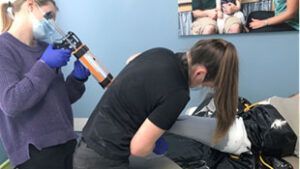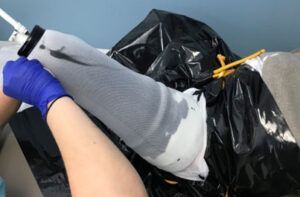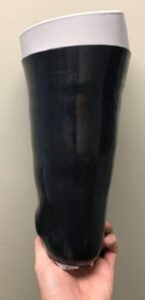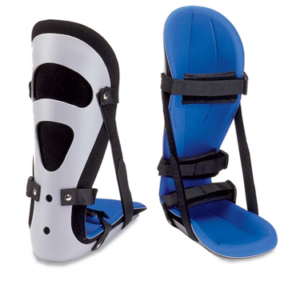Contact Us
The Direct Socket: The Science Behind This Innovative New Technology, How It Compares To Traditional Prosthetic Casting, And If It Is Right For You
Infinite Technologies Orthotics and Prosthetics has geographically partnered with Össur, the inventors of the Direct Socket, as the premier facility in the Capital Region to offer this exciting new prosthetic socket technology. With the Direct Socket system, a definitive prosthetic socket can be made right on an amputee’s leg in only a few hours instead of over several weeks. This blog will outline the benefits of direct socket vs traditional socket fabrication methods, science behind the direct socket, who is a good candidate for the direct socket, and how patients are doing in the direct socket.
Benefits of direct socket vs traditional socket fabrication methods
The traditional method of making prosthetic sockets typically consists of several steps spanning over an average of 16 weeks from initial evaluation to final delivery1. First, a cast or scan is taken of an amputee’s leg. Then, plaster is poured into a mold and modifications to the mold are made by a prosthetist. After the mold is ready, a plastic “check socket” is made then worn by the patient for several weeks. Issues with the fit of the check socket are then reviewed, and then a new check socket is made for and worn by an amputee for several more weeks. After an average of 2-3 check sockets, a definitive socket made of carbon fiber and resin is laminated on a mold of the inside of the patient’s most recent check socket. With the Direct Socket system, a definitive socket is laminated directly on a patient’s leg in only 4 hours, with no molds, no check sockets, and less visits into the office.
There are several advantages with being able to craft a definitive socket in one appointment. These include:
- Less trips and time spent in the office – Traditional socket fabrication takes an average of about 4 one-hour visits over a 16-week time span, with additional follow up appointments necessary1. The direct socket requires on average 2 appointments (measure for liners and then fabrication), with an average of only 1/3 of patients needing to follow up following delivery1.
- Ability to fabricate in clinical or rehab settings – Due to the direct socket being made directly on a patient’s limb in one appointment, a prosthetist is more portable than in the past.
- Optimized suspension and limb control – Traditional socket fabrication techniques require a clinician to perform modifications to a mold of an amputee’s leg. This leaves room for possible error. The direct socket is formed on a patient’s leg in real time, resulting in better socket fit, and reducing the chances of a socket not fitting correctly.
- Overall cost of rehabilitation and time from amputation to definitive leg is drastically reduced – It is estimated that a prosthesis accounts for only about 10% of total rehabilitation costs following amputation1. The bulk of rehab expenses come from the amount of time spent in rehabilitation. Reducing the amount of time between amputation and leg delivery can reduce rehabilitation costs by upwards of 25%, and research shows that shorter time to prosthetic fitting led to improved functional outcomes 6 months following amputation1.
Benefits of direct socket vs traditional socket fabrication methods
The technology for the direct socket originated in Scandinavia in the 1990s, but has only recently undergone rigorous testing and approval in the United States1. The direct socket laminates a final socket directly on a patient’s leg instead of on a mold.
First, a special casting liner is worn by the amputee, as well as a silicone protective sheath.
The materials for the socket are then applied to the limb, and a resin is added to harden the socket.



After the socket has hardened, a prosthetist draws on trimlines, and you get to walk out with a new definitive socket the same day.


Who is a good candidate for the direct socket?
- Transtibial and transfemoral amputees – The direct socket is available for transtibial, or below knee, and transfemoral, or above knee, amputees. If you have a bulbous end to your residual limb, or are a knee disarticulation patient, talk to your prosthetist and see if a direct socket could be right for you.
- All K Levels – Research has proven that amputees of all K levels, spanning from K1-K4 can benefit from the direct socket1,2.
- New and experienced prosthesis users – Research demonstrates the direct socket benefits new1 and experienced prosthesis users2 alike, with both groups significantly improving their Timed-Up-and-Go (TUG) Test and AMPPRO (the test which determines K level) scores when using a direct socket interface instead of a traditionally made socket, regardless of suspension style2. In the same study, even amputees who did not necessarily need a new socket due to improper fit or function scored better on their clinical outcome tests and overall comfort scores when wearing their direct socket at their 6 month follow up appointments2.
Who is a good candidate for the direct socket?
Research shows promising data on how patients are doing in the direct socket compared to traditional sockets.

Recent research demonstrates that amputees reported the direct socket significantly improved their stability, suspension, comfort, and they preferred the socket appearance compared to a socket made with traditional methods2. Not only are patients saying their direct sockets fit and feel better, but they are performing better on outcome measure tests in the direct socket. Direct socket users improved their Timed-Up-and-Go (TUG) Test by an average of 2-3 seconds compared to their baseline scores2. Multiple studies have shown that AMPRO scores, the test which determines K Level, have improved by an average of 2 points when using the direct socket system over a traditionally-made socket1-3.
If you have any questions about the direct socket system, please feel free to reach out to Infinite Technologies Orthotics and Prosthetics via email Contactus@infinitetech.org. Talk with your prosthetist and see if the direct socket is a good option for you, or call (703) 807-5899 to schedule your free consultation today!
References:
- Marable W.R, et al. Transfemoral socket fabrication method using direct casting: outcomes regarding patient satisfaction with device and services. Canadian Prosthetics and Orthotics Journal. 2020; Volume 3, Issue 2, No. 6. https://doi.org/10.33137/cpoj.v3i2.34672
- Walker J, et al. Clinical outcome of transfemoral direct socket interface (part 2). Canadian Prosthetics and Orthotics Journal. 2021; Volume 4, Issue 1, No.6. https://doi.org/10.33137/cpoj.36065
- Ennion, L et al. The use of a direct manufacturing prosthetic socket system in a rural community in South Africa: A pilot study and lessons for future research. Prosthetics and Orthotics International. 2017; Volume 4, Issue 5, pp 455-462. Https://doi.org/10.1177/03093646166839982




